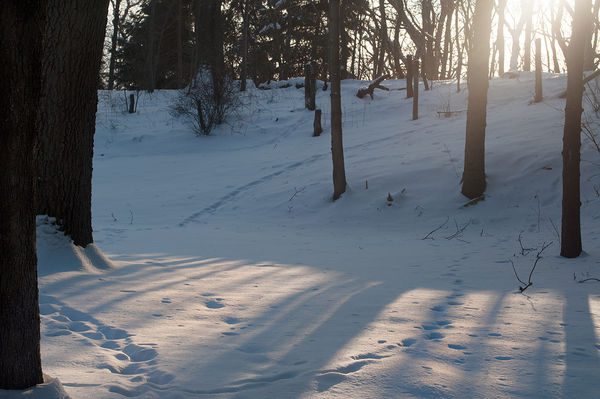Do others shoot with post processing in mind?
Feb 6, 2013 11:46:55 #
Often I shoot knowing I'll have to manipulate the photo, and wonder how many others do this, too. In this case, I knew the gamut in-camera could not handle what I saw, so I shot for the tracks in the snow, knowing that I'd have to adjust the curves, dodge and burn.
Shot with a Nikon D5000, 1/320, 10, ISO 200.
Shot with a Nikon D5000, 1/320, 10, ISO 200.
Sunrise and Tracks in Snow

Feb 6, 2013 12:03:36 #
artBob wrote:
Often I shoot knowing I'll have to manipulate the photo, and wonder how many others do this, too. In this case, I knew the gamut in-camera could not handle what I saw, so I shot for the tracks in the snow, knowing that I'd have to adjust the curves, dodge and burn.
The experienced photographer will always visualize the finished product before making the exposure. Thus, if the scene will require extensive post processing, the photographer is prepared. That, of course, is what you did in your example.
I always teach my students that the best images begin in the mind of the photographer.
Feb 6, 2013 12:03:54 #
Feb 6, 2013 12:37:37 #
Absolutely.
Pre visualization with the (post) process in mind. Whether just the in-camera process or PP in an editing program.
Digital and positive (slide) film often expose for the hightlights, process for the shadows.
Negative film, expose for the shadows develop for the highlights.
That is what the Zone system was all about.
Get the data in the image file to be able to get the final image you want.
If the dynamic (contrast) range of the scene does not equal the dynamic range of the sensor . . . ?
Pre visualization with the (post) process in mind. Whether just the in-camera process or PP in an editing program.
Digital and positive (slide) film often expose for the hightlights, process for the shadows.
Negative film, expose for the shadows develop for the highlights.
That is what the Zone system was all about.
Get the data in the image file to be able to get the final image you want.
If the dynamic (contrast) range of the scene does not equal the dynamic range of the sensor . . . ?
Feb 6, 2013 13:06:36 #
When I compose a shot, at some point before I trip the shutter I will consider possible PP needs. "If I compose this way, can I realistically clone out that thingy in the foreground or do I need to move?" "That composition will look great, especially if I go in and heavily saturate that blue in PP". "If I expose for this, I can use the adjustment brush in RAW to bring up the exposure in that corner to balance things out". If you have a preconceived idea of what you want your final image to look like, thinking about PP at the time of the shot is often a necessary part of the composition process.
(Edited addition). I guess I think it is related to A. Adams famous analogy that "the negative is he score, the print is the performance". It makes some sense to have one's performance in mind when writing the score.
(Edited addition). I guess I think it is related to A. Adams famous analogy that "the negative is he score, the print is the performance". It makes some sense to have one's performance in mind when writing the score.
Feb 6, 2013 13:15:45 #
I prefer to stay in the moment, enjoying the experience, NOT thinking. Right-brain vs. left?
Feb 6, 2013 13:19:29 #
If I'm printing my shots, sometimes I have to tweak the exposure a little because my printer prints photos a little darker than what's on the monitor. I don't take pictures with the idea of doing a lot of pp.
Feb 6, 2013 13:29:02 #
Feb 6, 2013 13:31:20 #
if its a paid session or for my website, everything is planned out before I push the shutter button, right down to my post work. i don't want to spend hours liquify belly rolls, or thinning down arms or legs so i watch the posing. Lighting not only helps light the image but with the right pose and lighting combo you can achieve some thinning effects as well. plus I tend to lean toward light and romantic looking images so I need to think about how my setup will look with that desired finish. does it look natural or forced?
Feb 6, 2013 13:37:07 #
Maybe a throwback to the old days, but I plan what I shoot and shoot what I plan. Doing it right the first time. Do very little pp work.
Feb 6, 2013 14:07:00 #
I visualize the end product and the post processing all the time. Whether it's stacking or HDR or simply a contrast and levels adjustment. In my mind, I know what I want the final image to look like and it rarely is what I see at the time.
Even Ansel Adams did post processing and they don't get much better than he.
Even Ansel Adams did post processing and they don't get much better than he.
Feb 6, 2013 14:27:04 #
Feb 6, 2013 14:38:33 #
Frank T wrote:
I visualize the end product and the post processing all the time. Whether it's stacking or HDR or simply a contrast and levels adjustment. In my mind, I know what I want the final image to look like and it rarely is what I see at the time.
Even Ansel Adams did post processing and they don't get much better than he.
Even Ansel Adams did post processing and they don't get much better than he.
Dodging and burning are steps to take care of mistakes God made in establishing tonal relationships. Adams.
And not just dodging and burning. His initial exposure decided upon by how the dynamic range could be expanded or compacted in the wet development of the negative and than again in the print development. Temperature, dual baths, dilution, time etc.
Pre visualization with the 'process' in mind.
Feb 6, 2013 15:16:18 #
In the digital age, it is even more important to consider your RAW file a "digital negative" which requires post processing.
First, essentially all digital SLR cameras do not see the world in focus, no matter the quality of the lens. Why? Digital is not analogue, and every "focused" item is built from a matrix of color receptors, rather than a single RGB point. This way of rendering an image cannot achieve the pristine focus of analog. It is a dither. Thus, at the very least, the soft world of digital must be post processed into focus, if you want digital to look more like analog. Further, the CCD and CMOS approach creates edge artifacts often seen on high contrast diagonals which are mostly, but not all, "corrected" by in-camera processing.
Then there is color shift. Digital uses precise color temperature settings, but the world is not precise. While you might fastidiously do white balances or try to use the right "scene setting" there will always be images which slip through with questionable or bad color. Post Processing, again.
Further, the Digital Darkroom offers tools never dreamed of in the chemical labs of the past. The needs of commercial work depends on this new creativity.
Finally, the digital world offers archival nature beyond the analog nature of silver gelatin prints which made Ansel Adams famous. In fact, not every Ansel Adams print which was sold was perfectly made. Insufficient washing has cropped up in the yellowing and fading of certain collector's prints, say, of the famous "Moonrise Hernandez." You HAVE to wash away ALL of the hypo, folks.
First, essentially all digital SLR cameras do not see the world in focus, no matter the quality of the lens. Why? Digital is not analogue, and every "focused" item is built from a matrix of color receptors, rather than a single RGB point. This way of rendering an image cannot achieve the pristine focus of analog. It is a dither. Thus, at the very least, the soft world of digital must be post processed into focus, if you want digital to look more like analog. Further, the CCD and CMOS approach creates edge artifacts often seen on high contrast diagonals which are mostly, but not all, "corrected" by in-camera processing.
Then there is color shift. Digital uses precise color temperature settings, but the world is not precise. While you might fastidiously do white balances or try to use the right "scene setting" there will always be images which slip through with questionable or bad color. Post Processing, again.
Further, the Digital Darkroom offers tools never dreamed of in the chemical labs of the past. The needs of commercial work depends on this new creativity.
Finally, the digital world offers archival nature beyond the analog nature of silver gelatin prints which made Ansel Adams famous. In fact, not every Ansel Adams print which was sold was perfectly made. Insufficient washing has cropped up in the yellowing and fading of certain collector's prints, say, of the famous "Moonrise Hernandez." You HAVE to wash away ALL of the hypo, folks.
Feb 6, 2013 15:37:27 #
The ONLY time I shoot with PP in mind is if I am looking for backgrounds to layer into portraits, etc.
I 'always' try to get the results I want straight from the camera, but also know that 'sometimes' there will have to be minor tweaking later.
I 'always' try to get the results I want straight from the camera, but also know that 'sometimes' there will have to be minor tweaking later.
If you want to reply, then register here. Registration is free and your account is created instantly, so you can post right away.










